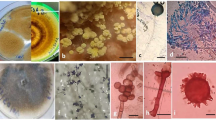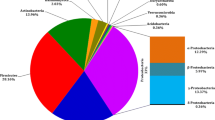Abstract
A Cd-, Pb-, Zn-, Cu-resistant endophytic yeast CBSB78 was isolated from surface-sterilized rape roots. The isolate was identified as Cryptococcus sp. based on the ITS1–5.8S–ITS2 sequence analysis. The strain was resistant to 20 mM Cd2+, 20 mM Pb2+, 10 mM Zn2+, and 7 mM Cu2+. The yeast CBSB78 was a low indole-3-acetic acid (IAA) producer and possessed low 1-aminocyclopropane-1-carboxylic acid (ACC) deaminase activity. Overall, 29.4–244 % of survival rates increased and the dry weight of Brassica alboglabra showed a 41.1 % increase when it was inoculated into the seedlings. The inoculation of CBSB78 could also increase the extraction amounts of Cd, Pb, and Zn by B. alboglabra simultaneously in the multi-metal contaminated soils, which showed the potential to improve extraction efficacy of Cd, Pb, Zn by B. alboglabra seedlings in the field.






Similar content being viewed by others
References
Bouaid, A., Martinez, M., & Aracil, J. (2009). Production of biodiesel from bioethanol and Brassica carinata oil: oxidation stability study. Bioresource Technology, 100, 2234–2239.
Cao, L., Jiang, M., Zeng, Z., Du, A., Tan, H., & Liu, Y. (2008). Trichoderma atroviride F6 improves phytoextraction efficiency of mustard (Brassia juncea (L) Coss. var. foliosa Bailey) in Cd, Ni contaminated soils. Chemosphere, 71, 1769–1773.
Cardone, M., Mazzoncini, M., Menini, S., Rocco, V., Senatore, A., Seggiani, M., et al. (2003). Brassica carinata as an alternative oil crop for the production of biodiesel in Italy: agronomic evaluation, fuel production by transesterification and characterization. Biomass and Bioenergy, 25, 623–636.
Cho, D. H., & Kim, E. Y. (2003). Characterization of Pb2+ biosorption from aqueous solution by Rhodotorula glutinis. Bioprocess and Biosystems Engineering, 25, 271–277.
Cloete, K. J., Valentine, A. J., Stander, M. A., Blomerus, L. M., & Botha, A. (2009). Evidence of symbiosis between the soil yeast Crytococcus laurentii and a sclerophyllous medicinal shrub, Agathosma betulina (Berg.) Pillans. Microbial Ecology, 57, 624–632.
D’Annibale, A., Rosetto, F., Leonardi, V., Federici, F., & Petruccioli, M. (2006). Role of autochthonous filamentous fungi in bioremediation of a soil historically contaminated with aromatic hydrocarbons. Applied and Environmental Microbiology, 72, 28–36.
Deng, Z., Cao, L., Huang, H., Jiang, X., Wang, W., Shi, Y., et al. (2011). Characterization of Cd- and Pb-resistant fungal endophyte Mucor sp. CBRF59 isolated from rapes (Brassica chinensis) in metal contaminated soils. Journal of Hazardous Materials, 185, 717–724.
Doty, S. L. (2008). Enhancing phytoremediation through the use of transgenics and endophytes. New Phytologist, 179, 318–333.
El-Tarabily, K. A. (2008). Promotion of tomato (Lycopersicon esculentum Mill.) plant growth by rhizosphere competent 1-aminocyclopropane-1-carboxylic acid deaminases- producing streptomycete actinomycetes. Plant and Soil, 308, 161–174.
El-Tarabily, K. A., & Sivasithamparam, K. (2006). Potential of yeasts as biocontrol agents of soil-borne fungal plant pathogens and as plant growth promoters. Mycoscience, 47, 25–35.
Hontzeas, N., Richardson, A. O., Belimov, A., Safronova, V., Abu-Omar, M. M., & Glick, B. R. (2005). Evidence for horizontal transfer of 1-aminocyclopropane-1-carboxylate deaminase genes. Applied and Environmental Microbiology, 71, 7556–7558.
Isaeva, O. V., Glushakova, A. M., Garbuz, S. A., Kachalkin, A. V., & Chernov, I. Y. (2010). Endophytic yeast fungi in plant storage tissues. Biology Bulletin, 37, 26–34.
Jiang, M., Cao, L. X., & Zhang, R. D. (2008). Effects of Acacia (Acacia auriculaeformis A. Cunn)-associated fungi on mustard (Brassica juncea (L.) Coss. var. foliosa Bailey) growth in Cd- and Ni-contaminated soils. Letters in Applied Microbiology, 47, 561–565.
Ksheminska, H., Jaglarz, A., Fedorovych, D., Babyak, L., Yanovych, D., Kaszycki, P., et al. (2003). Bioremediation of chromium by the yeast Pichia guilliermondii: toxicity and accumulation of Cr (III) and Cr (VI) and the influence of riboflavin on Cr tolerance. Microbiological Research, 158, 59–67.
Kuiper, I., Lagendijk, E. L., Bloemberg, G. V., & Lugtenberg, B. J. J. (2004). Rhizoremediation: a beneficial plant–microbe interaction. Molecular Plant-Microbe Interactions, 17, 6–15.
Lai, X., Cao, L., Tan, H., Fang, S., Huang, Y., & Zhou, S. (2007). Fungal communities from methane hydrate-bearing deep-sea marine sediments in South China sea. The ISME Journal, 1, 756–762.
Lebeau, T., Braud, A., & Jézéquel, K. (2008). Performance of bioaugmentation-assisted phytoextraction applied to metal contaminated soils: a review. Environmental Pollution, 153, 497–522.
Mehra, R. K., & Winge, D. R. (2004). Metal ion resistance in fungi: molecular mechanisms and their regulated expression. Journal of Cellular Biochemistry, 45, 30–40.
Nassar, A. H., El-Tarabily, K. A., & Sivasithamparam, K. (2005). Promotion of plant growth by an auxin-producing isolate of the yeast Williopsis saturnus endophytic in maize (Zea mays L.) roots. Biology and Fertility of Soils, 42, 97–108.
Newman, L. A., & Reynolds, C. M. (2005). Bacteria and phytoremediation: new uses for endophytic bacteria in plants. Trends in Biotechnology, 23, 6–8.
Perego, P., & Howell, S. B. (1997). Molecular mechanisms controlling sensitivity to toxic metal ions in yeast. Toxicology and Applied Pharmacology, 147, 312–318.
Rajkumar, M., Ae, N., & Freitas, H. (2009). Endophytic bacteria and their potential to enhance heavy metal phytoextraction. Chemosphere, 77, 153–160.
Rosewarne, C. P., Pettigrove, V., Stokes, H. W., & Parsons, Y. M. (2010). Class1integrons in benthic bacterial communities: abundance, association withTn402-like transposition modules and evidence forcoselection with heavy-metal resistance. FEMS Microbiology Ecology, 72, 35–46.
Ryan, R., Germaine, K., Franks, A., Ryan, D. J., & Dowling, D. N. (2008). Bacterial endophytes; recent developments and applications. FEMS Microbiology Letters, 278, 1–9.
Segura, A., Rodríguez-Conde, S., Ramos, C., & Ramos, J. L. (2009). Bacterial responses and interactions with plants during rhizoremediation. Microbial Biotechnology, 2, 452–464.
Sessitsch, A., & Puschenreiter, M. (2008). Endophytes and rhizosphere bacteria of plants growing in heavy metal-containing soils. In P. Dion & C. S. Nautiyal (Eds.), Microbiology of extreme soils (pp. 317–332). Germany: Springer-Verlag.
Sheng, X. F., Xia, J. J., Jiang, L. Y., He, L. Y., & Qian, M. (2008). Characterization of heavy metal-resistant endophytic bacteria from rape (Brassica napus) roots and their potential in promoting the growth and lead accumulation of rape. Environmental Pollution, 156, 1164–1170.
Tani, A., Zhang, D., Duine, J. A., & Kawai, F. (2004). Treatment of the yeast Rhodotorula glutinis with AlCl3 leads to adaptive acquirement of heritable aluminum resistance. Applied Microbiology and Biotechnology, 65, 344–348.
Usuki, F., & Narisawa, K. (2007). A mutualistic symbiosis between a dark septate endophytic fungus, Heteroconium chaetospira, and a nonmycorrhizal plant, Chinese cabbage. Mycologia, 99, 175–184.
Vadkertiová, R., & Sláviková, E. (2006). Metal tolerance of yeasts isolated from water, soil and plant environment. Journal of Basic Microbiology, 46, 145–152.
Wenzel, W. W. (2009). Rhizophere processes and management in plant-assisted bioremediation (phytoremediation) of soils. Plant and Soil, 321, 385–408.
Weyens, N., Croes, S., Dupae, J., Newman, L., van der Lelie, D., Carleer, R., et al. (2010). Endophytic bacteria improve phytoremediation of Ni and TCE co-contamination. Environmental Pollution, 158, 2422–2427.
Wright, M. S., Peltier, G. L., Stepanauskas, R., & McArthur, J. V. (2006). Bacterial tolerances to metal and antibiotics in metal-contaminated and reference streams. FEMS Microbiology Ecology, 58, 293–302.
Xin, G., Glawe, D., & Doty, S. L. (2009). Characterization of three endophytic, indole-3-acetic acid-producing yeasts occurring in Populus trees. Mycological Research, 113, 973–980.
You, J. L., Cao, L. X., Liu, G. F., Zhou, S. N., Tan, H. M., & Lin, Y. C. (2005). Isolation and characterization of actinomycetes antagonistic to pathogenic Vibrio spp. from nearshore marine sediments. World Journal of Microbiology and Biotechnology, 21, 679–682.
Acknowledgements
This work was partly supported by grants from the Chinese National Natural Science Foundation (Nos. 51039007 and 51179212), the Research Fund Program of Guangdong Provincial Key Laboratory of Environmental Pollution Control and Remediation Technology (2011K0004), and the Fundamental Research Funds for the Central Universities.
Author information
Authors and Affiliations
Corresponding author
Rights and permissions
About this article
Cite this article
Deng, Z., Wang, W., Tan, H. et al. Characterization of Heavy Metal-Resistant Endophytic Yeast Cryptococcus sp. CBSB78 from Rapes (Brassica chinensis) and Its Potential in Promoting the Growth of Brassica spp. in Metal-Contaminated Soils. Water Air Soil Pollut 223, 5321–5329 (2012). https://doi.org/10.1007/s11270-012-1282-6
Received:
Accepted:
Published:
Issue Date:
DOI: https://doi.org/10.1007/s11270-012-1282-6




